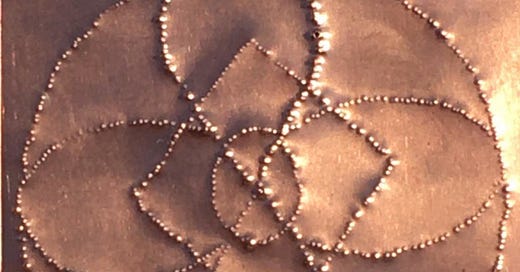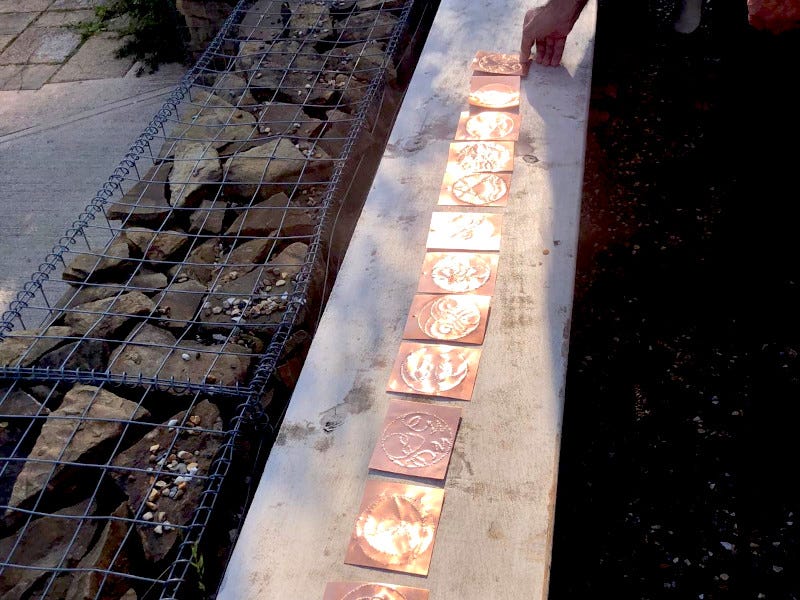The sound of hammering, nails against copper plate, moves across the otherwise silent craft space of Emerson College. We are making cosmograms in the afternoon sun. But what are cosmograms? ask the passersby who are now suddenly drawn like iron filings to these hunched-over crafts-people using an old celtic way of decorating their metal. We answer carefully that cosmograms are a way of plugging into ‘the universal language of the world’ and we are making them to hold conversation with the ‘other than humans’ in this place. The answer goes down well, no questions asked. We are with Slovenian artist Marko Pogacnik.
Marko, has been a UNESCO peace artist for many years and has left cosmograms like these all over the world. They are beautiful, strangely familiar, symbolic images impressed into stone or metal and placed onto points on the land that need rebalancing. It is his form of acupuncture (or litho-puncture) for the earth’s body and he is famous for it. His most public artwork can be seen on the Slovenian national flag. “Cosmograms”, he says, “are a language that other beings can relate with”. They act as a bridge between us, something that both sides can understand. So I, in my quest to find the ‘common wild tongue’ of nature, am keen to see if they work.
The images that we are inscribing on our squares of soft copper, have arisen directly from the waters, trees and landscapes that we have been working with here. They are the essence of these places that rise out of the relationship between us, as we go through a variety of meditative practices and movements. They are our intuitive understanding of what the ‘other’ is about when we listen with all senses alert, body, imagination, heart, for glimmers of subtle communication. It is like dowsing the under-girding movements of nature but without the rods, and it rests upon the assumption that life is intelligent, that communication with place is possible.
“This communication works through resonance” says Marko which at first sounds a bit elusive and improbable, but we are finding out by experience there is remarkable potency in it. “Cosmograms are composed of lines that have specific vibrational qualities, like the lines in a square have a different vibrational quality to a circle. You compose the lines in such a way that the sounds coming out are an expression of the place”. So … somehow, with a good dollop of trust in the process, an imaginative flip that is different for everyone, and a creative synthesis of perception, we translate our sense of place into lines, into an overall image, that we are certain, and all of us are, is a mirror of the places we are working with.
“The problem we have” continues Marko, “is that plants, animals, minerals and landscapes do not understand human language”. Over time, most of us have become isolated from the rest of the world, particularly as our languages have evolved further and further away from the original indigenous tongues that would have arisen with us out of the natural language of all things. Even those people around the world who still hold their valuable indigenous language (the “old faith people” of Slovenia did not lose theirs until late last century) are struggling to harmonise with nature because people and places are transforming so rapidly.
Whilst we can learn so much from these languages, even from the fragments, another perhaps more adaptable way of connecting ourselves back is to develop what Marko calls an ‘open language’ that can be discovered in direct relationship with other beings. “It is not in the dictionary” he says, “it is not passed down from generation to generation, it is open and accessible to everyone and there are many different pathways you can develop it for yourself”. All of us are in relationship with place and the beings around us, we can learn to speak a common tongue understood by both sides if we can just develop our perception.
“There are two types of people I have worked with”, says Marko, when it comes to developing perception. “There are those who speak the language of imagination” and by this he means the people who receive images when they attempt to communicate with the natural world, “and those who speak the language of presence”. The latter is fascinating, because people don’t realise they are doing it, if they listen hard and don’t receive words or images they think communication is not possible. “But if you are fully present in a place, if you are embodying it” he says, “an inner alchemy starts to work, an in-depth communication goes on and later, the next day, or the next month, there is a knowledge, a flash of inspiration that comes from it”.
This happens anyway, whether we are aware of it or not, and the method cannot be taught because it depends on the individual. It seems that we just have to practice, to make time for it, and the more we can share and compare with others, the more we begin to develop languages, like that of the cosmogram, that everyone can understand, including those places we are attempting to communicate with. “There are two sides to the language of cosmograms” says Marko, “one side is that humans can understand, the other is that beings that don’t have eyes can feel or hear the vibrations. It is a symbolic language, a language of resonance - places have the same difficulty we do, how to express themselves so that humans get it”.
There is something in Marko’s talk of perception and resonance, perhaps in the making of the cosmograms themselves that creates its own resonance, that drops a large penny for me, as we complete our hammering and hang our work in the places and trees that co-created these pieces of art with us. I fully recognise his understanding of this language of presence. I have noticed lately that the more time I spend in the presence of trees and mountains, listening hard, waiting patiently for images that don’t always come, the more I am able to navigate the world through intuition alone, the more I can rely on flashes of inspiration and synchronicity to signpost the way in fast changing times.
Later on, whilst I’m meditating amongst brassicas in the magnificent vegetable garden of Emerson College, I feel an unfamiliar presence arrive, just fleetingly. I say out loud, in my inadequate human language, “I can’t see you but I know you’re here”. I think of the invitation of my cosmogram, vibrating from the symbol I inscribed on it, I think of our commitment to make something solid from the imaginal realm that sits between us and intelligent nature, and offer it back as a gesture, as gratitude. Why shouldn’t it work? I am grateful for the visitation, I am open to more, I am committed to this new and quite strange way of communicating with the world.
Recommended book: Monica Gagliano, Thus Spoke The Plant
Australian plant scientist Monica Gagliano was the first to show in the laboratory that plants could communicate with each other through sound and then respond to what they heard. Until this experiment this was not thought possible because plants do not have brains like ours. This beautiful story tells of how her inspiration for experiment was given during plant communication ceremonies in Peru, weaving science and direct experience together.
Listening To The Land Podcast: Afro-ecology with Sandra Salazar and Kandake Makonnen
I talk to two deeply soulful afro-ecologists working with women and children of African and Caribbean heritage in London, to 'go grow food with love'. From living in a Rastafarian community in Jamaica to initiating in the Dogon tradition of West Africa, we talk about how the earth speaks with all of us, in different languages, and it's time to put our pieces together.
Nature Scriptorium: Join Our Online Animist Writing Circle at Animate Earth
20 Sept - 9 April 2026
With Rachel Fleming, Colin Campbell and Manda Scott
And Special Guests Rachel Jamison Webster, Hazel Marshall, Maddy Harland, Erica Nunally, Tom Hirons, John Higgins and Polly Atkin
We will soon gather across the world, as activist scribes of the as-yet unseen, tuning our animal ears to the common wild tongue of nature and finding ways of expressing what we hear, for ourselves and our communities, for our ancestors past, present and future.
https://animate-earth.org/nature-scriptorium-writers-retreat/







A beautiful sharing Rachel, and a reminder of the power and depth of resonance that vibrates and connects all life.
Thank you